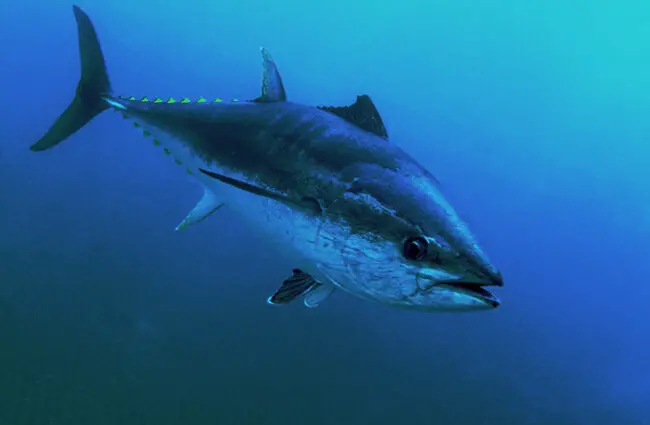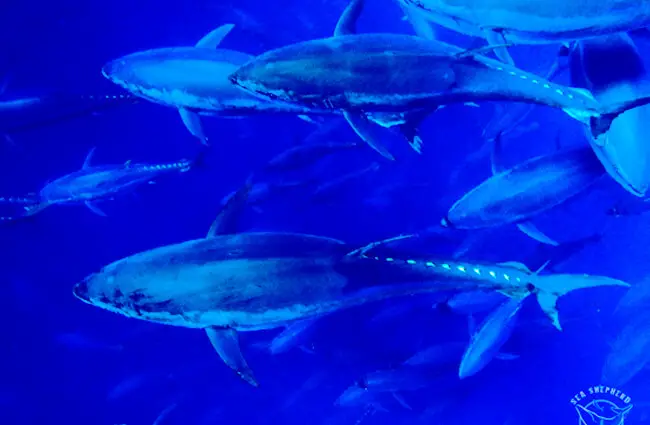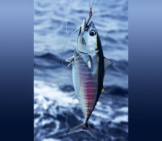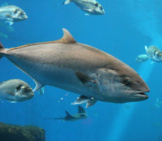People refer to several different species as “Bluefin Tuna.” In general, the taxonomic genus Thunnus contains all eight tuna species, and scientists consider the subgenus Thunnus (Thunnus) as the “bluefin group.” However, the three species named “bluefin” include the Southern, Atlantic, and Pacific. Read on to learn about the Bluefin Tuna.
Description of the Bluefin Tuna
All three species in this group have a typical tuna shape. They have streamlined, muscular, torpedo-shaped bodies with a set of short finlets before their tail fins. Compared to the other tuna species, this group has short pectoral fins.
Each species has its own unique size and weight range. At their largest, these fish reach over 8 ft. long, and some specimens can exceed 500 lbs.
Interesting Facts About the Bluefin Tuna
These fish have several interesting traits and adaptations. Learn more about them, below.
- Endothermic – Unlike most other fish, which cannot regulate their body temperature, these fish have endothermic circulatory systems. This means that they can regulate their body temperature, just like mammals can.
- Advantages of Endothermy – The ability to maintain their body temperature allows these fish to swim in colder waters, such as subarctic regions or deep beneath the surface, without losing speed or strength.
- Fishing Pressure – All three species in this group face some level of fishing pressure that causes decline in their populations. The IUCN lists the Pacific species as Vulnerable, the Atlantic species as Endangered, and the Southern species as Critically Endangered.
Habitat of the Bluefin Tuna
While each species has its own specific habitat preferences, all three species in this group have pelagic lifestyles. This means that they live in open water and do not generally rely on the sea floor. Their depth preference varies by species, some live in deeper waters than others.
Distribution of the Bluefin Tuna
Each species has its own specific distribution and range, but all three have cosmopolitan distribution. The southern species lives across the globe in waters just north of Antarctic polar regions. As their names suggest, the Pacific and Atlantic species utilize tropical and temperate waters in the Pacific and Atlantic oceans.
Diet of the Bluefin Tuna
All three species have carnivorous feeding habits, which means that they eat other animals. They have primarily piscivorous diets, as they feed mostly on fish and squid.
As each species lives in a different region, they each prey on different species of fish and squid. Larger species prey on larger fish, while smaller species and individuals target smaller prey.
Bluefin Tuna and Human Interaction
Humans have heavily harvested this species as a source of food. People hunt these fish in both commercial fisheries and recreationally. Overfishing has put immense pressure on each of the populations, and consequently, severe decline has occurred.
The IUCN lists the Pacific species as Vulnerable, the Atlantic species as Endangered, and the Southern species as Critically Endangered.
Domestication
Humans have not domesticated these fish in any way.
Does the Bluefin Tuna Make a Good Pet
No, you could not keep this fish as a pet. They reach sizes much too large to keep in a home aquarium.
Bluefin Tuna Care
Some people keep certain species in fish farm operations, and people sometimes keep these fish in public aquariums as well. Facilities must use massive tanks or pens to keep the fish, as they swim constantly and reach impressive sizes. As social fish, they must also keep them in schools. Caretakers feed the fish a variety of bait fish, such as smelt, capelin, herring, sardine, and more.
Behavior of the Bluefin Tuna
These tunas have active, social behavior. They swim constantly, moving swiftly through the water hunting their prey. All three species live in groups known as schools. The schools also swim with other predatory fish species, such as other tuna, particularly during lengthy migrations.
Reproduction of the Bluefin Tuna
All tuna reproduce via spawning, where both sexes release their eggs and sperm into the water, and fertilization occurs outside of the body. Water temperature or season typically dictates when the fish spawn. Larger females produce greater numbers of eggs. A single female can lay several million eggs in one season.











![Red Angus Closeup of a beautiful Red Angus cowPhoto by: U.S. Department of Agriculture [pubic domain]https://creativecommons.org/licenses/by/2.0/](https://animals.net/wp-content/uploads/2020/03/Red-Angus-4-238x178.jpg)


![Red Angus Closeup of a beautiful Red Angus cowPhoto by: U.S. Department of Agriculture [pubic domain]https://creativecommons.org/licenses/by/2.0/](https://animals.net/wp-content/uploads/2020/03/Red-Angus-4-100x75.jpg)

